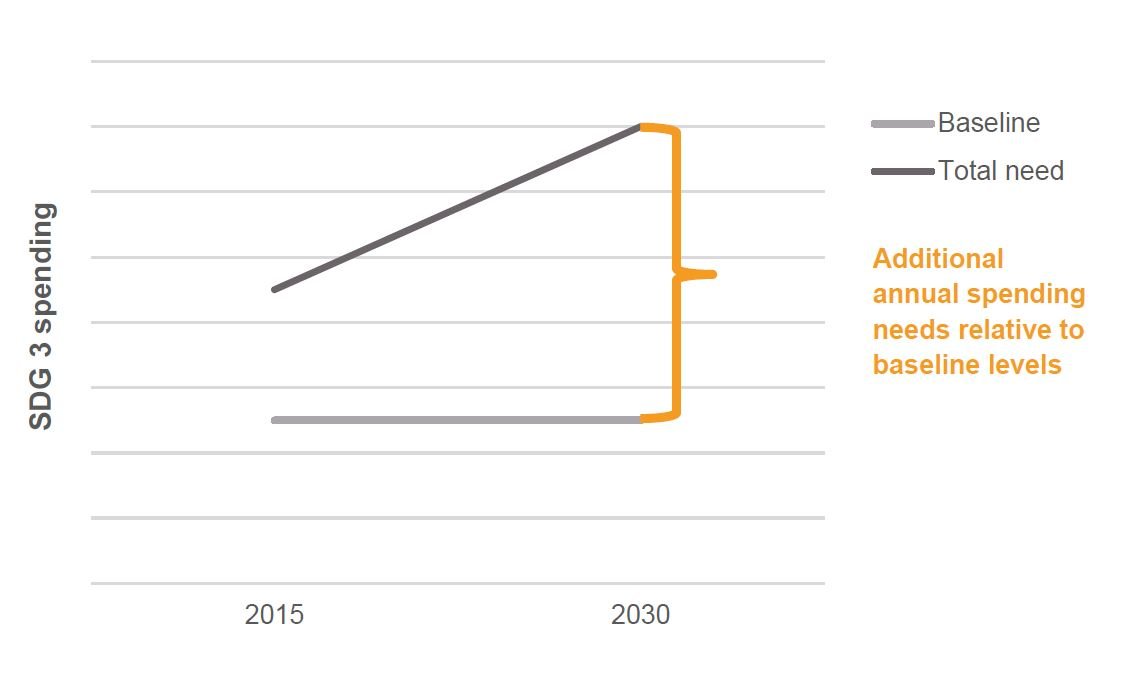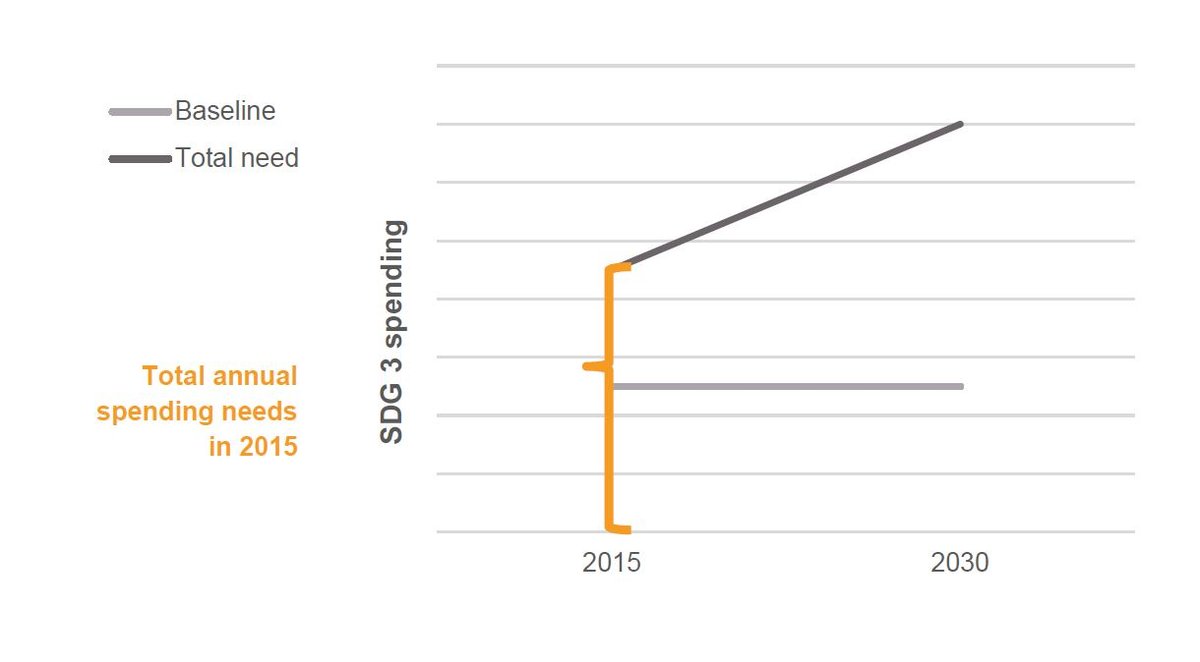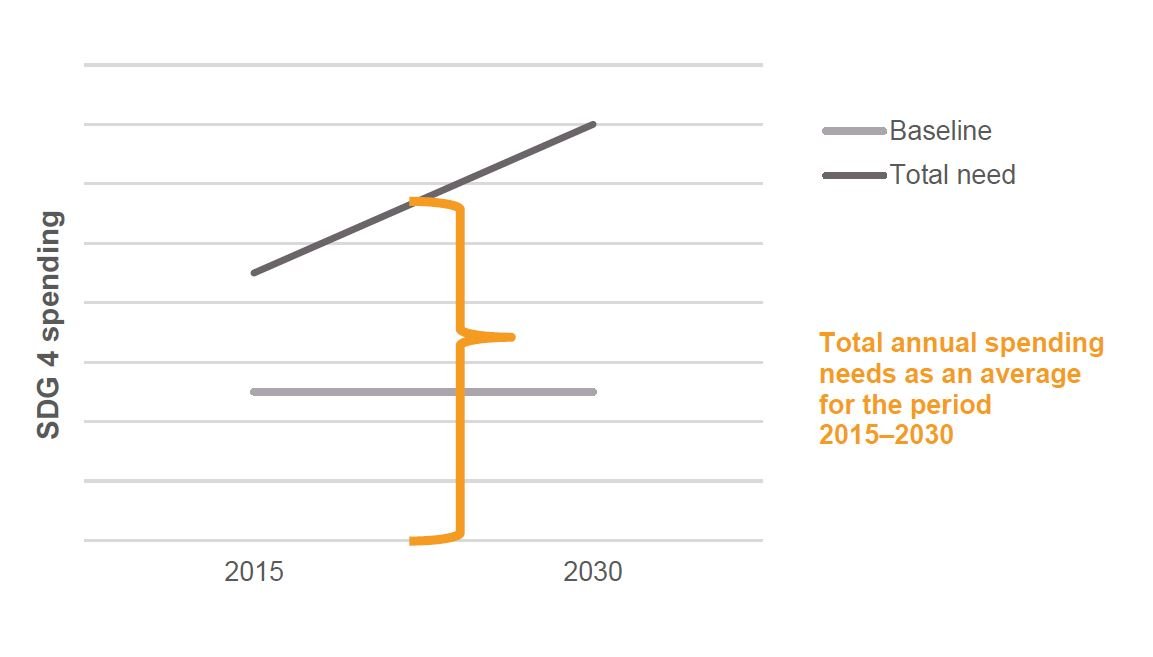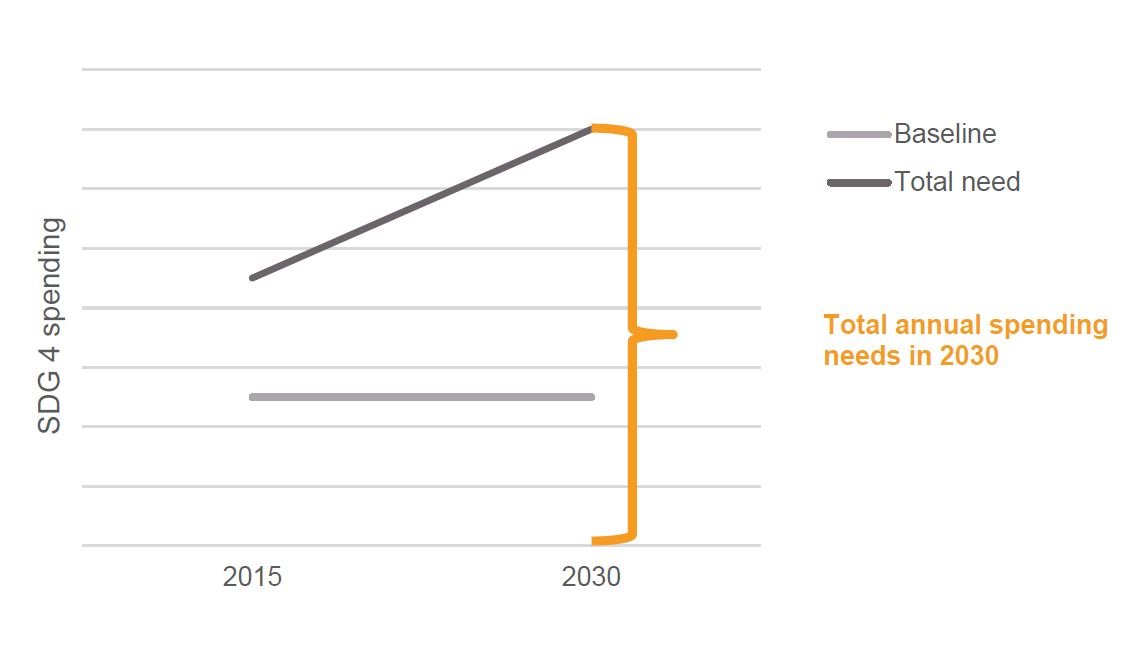The cost of achieving SDG 3 and SDG 4: How complete are financing estimates for the health and education goals?
We need to re-examine current financing estimates for achieving the SDGs if we are to leave no one behind. This background paper focuses on SDG 3 and SDG 4 – the health and education goals.
DownloadsIntroduction
The United Nations’ Sustainable Development Goals (SDGs) are a set of global commitments, adopted by all Member States, that must be met as part of the Agenda for Sustainable Development (Agenda 2030). There are 17 SDGs, which cover global challenges including poverty, inequality, climate change, environmental degradation, peace and justice. The SDGs also contain an overarching commitment to “leave no one behind”. This means ensuring that they are “met for all nations and peoples and for all segments of society” by “reach[ing] the furthest behind first”. [1]
This paper explores the costs required to achieve two of the SDGs and ensure no one is left behind:
- SDG 3 – ensure healthy lives and promote well-being for all at all ages.
- SDG 4 – ensure inclusive and equitable quality education and promote lifelong learning opportunities for all.
The majority of the paper provides an analysis of four existing costings – two for each of the SDGs – and highlights the most important gaps in these estimates. It proposes that current costings do not adequately incorporate “leave no one behind” considerations – such as the additional cost of reaching the poorest and most marginalised people (the very people that Agenda 2030 commits us to reach first).
The paper concludes that more comprehensive estimates of health and education costs are important in helping decision-makers to further optimise financing allocations, including official development assistance (ODA), during the last crucial decade of the SDG agenda.
Financing the SDGs and leaving no one behind
As we enter the Decade of Action for delivering on the SDGs, [2] attention is increasingly being placed on how to use all available financing to maximum effect. Robust estimates of the cost of achieving SDGs are essential to ensure that resources are spent effectively and according to their comparative advantage.
In the case of ODA, accurate costings mean providers can better plan how much is needed to achieve the goals and identify areas where ODA may have a comparative advantage over other providers of finance. ODA’s core purpose of poverty reduction makes it well-suited to achieving equitable outcomes in sectors where more profit-seeking finance may struggle to leave no one behind. [3] SDGs 3 and 4 are therefore areas where ODA has a particularly important role to play.
Why is investment in SDG 3 and SDG 4 important?
SDGs 3 and 4 deserve attention for a number of reasons. First, they are vital goals in their own right: achieving them will make the difference between people thriving or living in misery – and sometimes even the difference between life or death. [4] Second, both have an important part to play in ensuring that other SDGs are met. [5] For example, health can have important effects on the reduction of poverty (SDG 1), education outcomes (SDG 4) and gender equality (SDG 5). [6] Meanwhile education can have a positive influence on reducing poverty (SDG 1), tackling child mortality (SDG 3.2) and responsiveness to climate-related disasters (SDG 13), among other Goals. [7] In addition, better investment in people is now widely considered as fundamental to greater equity and economic growth. [8]
Analysis of existing costings
Several studies have been published that propose costings and methodologies for health (SDG 3) and education (SDG 4). The results presented in this paper are based on an in-depth review of four main studies – two for each SDG. These were selected on the basis of relevance; comprehensiveness; recent publication date; extent of citation and/or use as a key reference in other literature; and endorsement by a high-level stakeholder, such as the World Health Organization (Study 1), the World Bank (Study 2), UNESCO (Study 3) and a high-profile international commission on education (Study 4).
The next two sections of this report briefly outline the content, methodology and estimated costs provided by each of the four studies, highlighting what is covered and illustrating the differences between them.
Table 1: Summary of reviewed costings for SDGs 3 and 4
| SDG 3 | Study 1: estimated cost is an additional US$307–416 billion* per year by 2030 | Study 2: estimated cost is a total US$227 billion per year in 2015 |
|---|---|---|
| SDG 4 | Study 3: estimated cost is a total US$222 billion** on average between 2015 and 2030 | Study 4: estimated cost is a total US$3 trillion per year by 2030 |
Notes: *All results are expressed in 2018 constant prices to facilitate comparability. (Calculated using using the World Bank GDP deflator data for low- and middle-income countries. See World Bank, Data: Inflation, GDP deflator, https://data.worldbank.org/indicator/NY.GDP.DEFL.KD.ZG (accessed 23 November 2019).
**The documents available online do not explicitly link the estimate to a specific year’s prices. Based on other information in the documents, we have assumed that Wils’ estimate was originally stated in 2012 prices. If instead it was stated in 2013 or 2014 prices, the 2018 equivalent would be somewhat higher – US$316 billion or US$381 billion respectively.
SDG 3: Ensure healthy lives and promote well-being for all at all ages
Study 1: Stenberg et al. (2017) [9]
Approach: Costs were calculated based on the delivery of 187 priority interventions and strengthening of health systems in 67 low- and middle-income countries. The estimate comprises additional annual spending needs in 2030 relative to baseline levels (Figure 1).
Methodology: Stenberg et al. took country-specific data on demographics, input costs and target outcomes. They then applied a range of specialised costing tools for the various priority interventions and steps to strengthen health systems.
Study 2: Jamison et al. (2018) [10]
Approach: Costs were calculated based on delivering ‘essential universal health coverage’ in all low- and lower-middle-income countries. The estimate comprises total annual spending needs, as at 2015 (Figure 2).
Methodology: Jamison et al. took data on demographics, input costs, and target outcomes. They used a range of costing tools for the various interventions included in ‘essential universal health coverage’. They then applied a factor to cover the costs of system strengthening.
SDG 4: Ensure inclusive and equitable quality education and promote lifelong learning opportunities for all
Study 3: Wils, A. (2015) [11]
Approach: Costs were calculated based on achieving universal completion of pre-primary, primary, and lower secondary education by 2030; and putting in place the pre-conditions for universal completion of upper secondary education in all low- and lower-middle-income countries by 2030. [12] Measures to improve education quality were included in the analysis. The estimate comprises total annual spending needs as an average for the period 2015–2030 (Figure 3).
Methodology: Wils modelled future operating and infrastructure costs using demographic data, gross domestic product projections and target outcome levels.
Study 4: The Education Commission (2016) [13]
Approach: Costs were calculated based on achieving the aims set out in the ‘Learning Generation’ report [14] for all low- and middle-income countries. The Learning Generation report sets targets for 2040, with milestones in 2030 as follows:
- 96% of children enrol for two years’ pre-primary education
- 85% of children complete primary school and achieve learning benchmarks
- 64% of children complete secondary school and achieve ‘higher learning skills’
- 69% of young people access post-secondary education
- the average ratio of the wealthiest 20% to the poorest 20% of primary-school age children completing school and achieving learning benchmarks in low- and lower-middle-income countries does not exceed 1.5.
The estimate comprises total annual spending needs, as at 2030 (Figure 4).
Methodology: The Education Commission used a similar methodology to Wils. However, they took a different approach to calculating target outcome levels, based on observed high performers to-date. Several factors account for why the estimate presented in the Education Commission report is markedly higher than the one presented in Study 3. These include: coverage of upper-middle-income countries; timing (end versus average of SDG period); coverage of post-secondary education; and slightly different approaches to out-of-pocket costs.
Gaps in existing costings
Current estimates provide a sense of the scale of financing needed to achieve SDGs 3 and 4. However, they don’t adequately incorporate considerations related to Agenda 2030’s underlying principle of leaving no one behind. The most important missing elements in relation to this are:
-
The costs of scaling up to cover the full population
- Three out of the four costings that are reviewed in this paper assume that the number of people covered would be less than 100% of the population (Studies 1, 2 and 4).
-
The higher unit costs of reaching the most marginalised people and places
- Reaching marginalised population groups requires dedicated resources – for example, to produce health information in accessible formats for persons with disabilities [15] , or to run campaigns to tackle social norms that keep girls out of school. [16] Despite adjustments for certain dimensions of marginalisation (e.g. some of the consequences of living in a rural area or living in income poverty), the costings do not address such resource needs comprehensively.
- Some challenging country contexts – such as small island developing states – are not included in the health costing estimates presented in Study 1, due to data gaps and an emphasis on countries with higher populations. [17]
-
The costs of some health interventions
- The authors of the health costings exclude some interventions, on the grounds that less data is available (e.g. in Study 1), or that they are less essential. To summarise all the interventions that they excluded would require a paper in its own right – but to illustrate with a few examples: Study 1 excludes (among others) treatments for some cancers, hepatitis treatment and suicide reduction. The criteria used to decide which interventions are included, and which are excluded, may risk side-lining some marginalised groups – those whose conditions that have been under-researched, or those whose situation does not fit with prioritisation criteria such as the number of people affected by a disease, or a focus on working-age populations.
-
The costs of reaching people affected by future crises
- The costings do not consider in full how some kinds of future crisis – such as new wars and the effects of climate change – may add to the costs of achieving SDGs 3 and 4.
-
The full costs of moving to more equitable financing models.
- Out-of-pocket payments for healthcare and education risk exacerbating inequalities between those who can and cannot afford to pay. However, the estimate of the additional spending needs to meet SDG 3 presented in Study 1, and the costing for SDG 4 presented in Study 3, appear to assume that – even if out-of-pocket payments are reduced – some costs will continue to be met this way. Meanwhile, Study 4 does not exclude out-of-pocket payments from the discussion of how SDG 4 targets could be financed. [18]
Conclusion
Findings from this paper highlight outstanding gaps in our understanding of the amount of finance needed to ensure that the benefits of investments in the health and education sectors can extend to everyone, including the poorest and most marginalised people. Without filling these gaps, cost estimates cannot be used to inform donors on how much additional financing may be required to ensure those most at risk of being left behind are included in health and education progress, thus jeopardising effective decision-making on resource allocation, including on ODA.
With ten years to go until the SDG deadline of 2030, a more comprehensive picture of the true scale of financing – including the additional costs of reaching the poorest and most marginalised people and places as well as the full costs of moving to more equitable financing models – is needed to ensure healthy lives and promote well-being for all at all ages (SDG 3) and to ensure inclusive and equitable quality education and promote lifelong learning opportunities for all (SDG 4).
Building on past research, [19] Development Initiatives will continue to look at how donors can best engage and support accelerated progress in key poverty-reducing sectors such as health and education. We welcome your feedback and questions in this area and look forward to continued engagement on these topics.
Downloads
Notes
-
1
United Nations General Assembly, 2015. A/RES/70/1. Transforming our world: the 2030 Agenda for Sustainable Development. See paragraph 4. Available at: www.un.org/ga/search/view_doc.asp?symbol=A/RES/70/1&Lang=EReturn to source text
-
2
See United Nations, Sustainable Development Goals, Decade of Action, www.un.org/sustainabledevelopment/decade-of-action/ (accessed 17 March 2020)Return to source text
-
3
Development Initiatives, 2019. How blended finance reaches the poorest people. Available at: /publications/blended-finance-poorest-peopleReturn to source text
-
4
Kharas, H,. McArthur, J. and Rasmussen, K., 2018. Counting who gets left behind: current trends and gaps on the Sustainable Development Goals, Brookings [web blog], 13 July 2018, www.brookings.edu/blog/future-development/2018/07/13/counting-who-gets-left-behind-current-trends-and-gaps-on-the-sustainable-development-goals (accessed 17 March 2020)Return to source text
-
5
Nilsson, M., 2016. Understanding and mapping important interactions among SDGs. Available at: https://sustainabledevelopment.un.org/content/documents/12067Understanding%20and%20mapping%20important%20interactions%20among%20SDGs.pdf; UNESCO, 2016. Education for people and planet: creating sustainable futures for all. Available at: https://unesdoc.unesco.org/ark:/48223/pf0000245752Return to source text
Related content
Economic poverty trends: global, regional and national
Poverty is complex and it can be described and measured in a variety of ways. In this factsheet we unpack some of the key terminology alongside the latest trends in poverty at the global, regional and national levels.
Coronavirus and aid data: What the latest DAC data tells us
How might the coronavirus pandemic impact aid spending? DI presents analysis of preliminary ODA (aid) data for 2019. Our briefing shows how much was given and in what form.
ODA (aid) spending in 2018
DI presents analysis of the final ODA (aid) data for 2018. Our factsheet shows how much was given and in what form, as well as a breakdown of recipient countries and sectors, and the share of aid going to projects focused on climate or gender.



